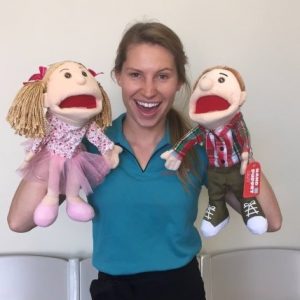 Puppets are a fun and exciting way encourage children to learn language and social skills. Their use allows children to learn to express themselves and interact with others in an exciting and engaging way. They are diverse, inexpensive and can be used with children of all ages. Some ways you can use puppets includes:
Puppets are a fun and exciting way encourage children to learn language and social skills. Their use allows children to learn to express themselves and interact with others in an exciting and engaging way. They are diverse, inexpensive and can be used with children of all ages. Some ways you can use puppets includes:
1. Developing the correct use of pronouns such as "he" and "she"
Pronouns can be challenging to learn and children may use the incorrect pronouns when talking. For example, they might use ‘he’ when talking about both girls and boy. Puppets can be used to model the correct use of ‘he’ and ‘she’ through repetitive language. We can model ‘he’ and ‘she’ using a boy and a girl puppet by:
- Describing the puppets. For example, you could say ‘she is wearing a skirt’, ‘she has blonde hair’, ‘he has green shoes’.
- Feeding the puppets food. For example, ‘She is eating a banana, she likes bananas, she is still hungry, what can she eat next?’
- Once your child can consistently use the correct pronouns, ask them to create sentences about the puppets. Encourage the correct use of ‘he’ and ‘she’.
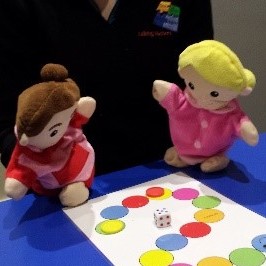 2. Coping with winning and losing
2. Coping with winning and losing
Winning and losing can be challenging for many children. Playing a simple board game using puppets teaches them that losing is okay. Allowing the child to be in control of both puppets avoids the situation of them personally winning or losing. When playing the game ask the child to help two puppets play a game. The child helps the puppets to play and you roll the dice. Following the game, you can role play what the puppets might say to each other:
- Amy- “I feel sad because I lost.”
- Mia- “That’s ok. You still played really well. I had fun playing with you.”
- Amy- “Thanks, I had fun too.”
- Mia- “Maybe you will win next time.”
- Puppets high-five/shake hands* and say ‘good game!’
3. Extending vocabulary
Children with communication difficulties may need support to expand their vocabulary. Using puppets provides a visual representation of the new words. Different puppets can be used to teach different vocabulary.
- Animal finger puppets can be used to teach animal names, animal body parts, animal noises, colours, patterns (eg. spots, stripes).
- Other puppets can be used to teach different vocabulary such as clothing, food, occupations, concepts including size (big/small, long/short)
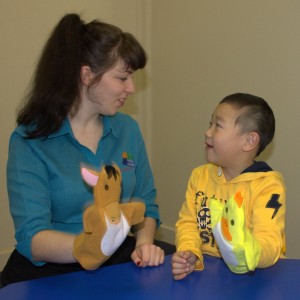 4. Understanding similarities and differences
4. Understanding similarities and differences
Similarities and differences may require explicit teaching. Often children can identify similarities, but have difficulties identifying differences.
- Teaching similarities and differences can be achieved by using two puppets. For example hair colour, eye colour, clothing, size (big nose/small nose) and length (long hair/short hair).
- Ask your child to identify similarities and differences between a puppet and themselves. For example, ‘He has green shoes and I have black shoes’.
5. Role playing socially appropriate behaviours
Some children, including those on the autism spectrum, find developing social skills challenging and require specific support to learn how to interact well with others. Puppets can be an effective way to develop these skills because you can change the situation to target the specific social skill.
A social story can be read first and then use the puppets to role play the behaviours learnt in the story. Some of the social behaviours and life skills that can be targeted include:
- Turn taking
- Sharing
- Greetings
- A and B choices
- Personal space
- Listening when others are talking
- Stranger danger
- Safely crossing the road
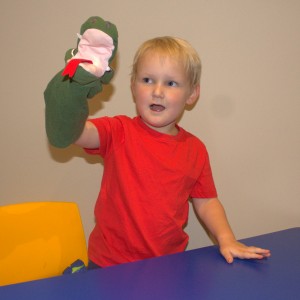 6. Establishing eye contact and greetings
6. Establishing eye contact and greetings
Some children find it difficult to use appropriate eye contact and it can be a difficult skill to teach. Two puppets can be used to demonstrate appropriate vs inappropriate eye contact, through role-playing a conversation. Ask your child to help identify whether the amount of eye contact between the puppets, during the conversation, was too little, too much or just right.
Then you can discuss why the use of eye contact is important. For example, if one puppet was looking up at the roof during the conversation, you could ask your child “Did they look like they were listening?”
Next, you can ask your child to participate in a conversation with the puppet and maintain appropriate eye contact.
7. Understanding action words
Children need to learn to use action words (verbs) in order to move from producing single words and phrases to using sentences.
Using verbs with puppets can be fun and exciting. You and your child can model the puppet performing actions such as eating, drinking, sleeping, hopping, jumping, walking, running, playing, laughing, coughing, singing, etc.
Once action words have been taught, they can be used to develop phrases. For example, using a subject and verb (e.g. Girl jumping, Harry eating) or with a verb and object (eg. walking home, eating cake).
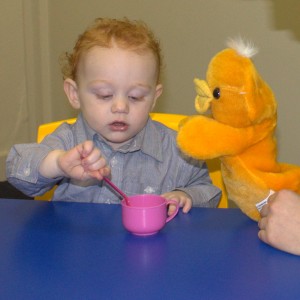 8. Developing past tense verb
8. Developing past tense verb
Past tense is necessary to indicate when something has already happened. This is used when telling stories or recounting events.
First demonstrate the action using the puppet. You can then ask your child ‘What did Sally just do?’ They can then answer ‘She walked’. This might take some time to practice and develop, particularly with irregular verbs.
- Regular verbs end in -ed. These include hopped, jumped, walked, played, laughed, coughed.
- Irregular verbs include ate, drank, slept, ran, sung, drew.
9. Developing Imaginative play skills
Puppets provide children with the opportunity to be creative by allowing them to role play different occupations and explore life skills. Play is essential for developing language, thinking, motor skills and social skills. For example, doctor or vet play is a great activity to develop these skills. The child takes on the role of the doctor and the puppets are the child’s patient.
Another activity may include food preparation and cooking for the puppets. This can use additional props from the kitchen to support creativity.
10. Reinforcing speech sound practice and handwriting practice!
Puppets are a great motivator to use when completing home practice. When practicing your child’s speech sounds you can try feeding the puppets the sound cards after each production. You can also try feeding the puppets pretend food or other homework tasks.
Looking for more fun ways to learn? Our website has a range of downloadable information sheets, printable activities and useful links. To connect with our community of families, therapists and educators join us on Facebook, Twitter and Pinterest.
Need support for your child? Talking Matters provides assessment, diagnosis,therapy and support for children with a wide range of needs including developmental delays, learning and literacy challenges, speech and language delays, motor skill and sensory issues and children on the autism spectrum and their families.We are providers under the NDIA. We provide speech pathology, occupational therapy, social skills and play skills groups. We provide services in local schools and our disability consultant can help teachers support children who are experiencing difficulties in school. To find out more about our servicesand our team visit our website.
We have a range of group programs coming up in the school holidays including one to develop preschool kids pretend play skills. browse our website or call our office on (08) 8255 7137 for details.
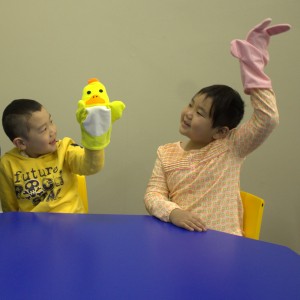 Rebecca McPherson and Stephanie Ecker
Rebecca McPherson and Stephanie Ecker
Speech Pathologists
Related Blog Posts
If you liked this post you may also like:
Why books for christmas
Language Games
Learning to Move
Memory and school



